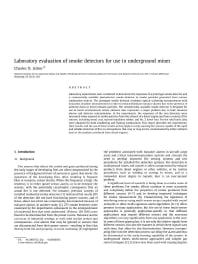Mining Publication: Laboratory Evaluation of Smoke Detectors for Use in Underground Mines
Original creation date: April 2009
Authors: CD Litton
Laboratory experiments were conducted to determine the responses of a prototype smoke detector and a commercially available photoelectric smoke detector to smoke particles generated from various combustion sources. The prototype smoke detector combines optical scattering measurements with ionization chamber measurements in order to reduce/eliminate nuisance alarms due to the presence of airborne dusts or diesel exhaust particles. The commercially available smoke detector is designed for use in harsh environments where airborne dust represents a major problem due to both nuisance alarms and detector contamination. In the experiments, the responses of the two detectors were measured when exposed to smoke particles from the exhaust of a diesel engine and from a variety of fire sources, including wood, coal, styrene butadiene rubber, and No. 2 diesel fuel. For the solid fuels, data were obtained for both smoldering and flaming combustions. This report describes the experiments, their results, and the use of these results as they apply to early-warning fire sensors capable of the rapid and reliable detection of fires in atmospheres that may or may not be contaminated by either airborne dust or the products produced from diesel engines.

- A Comparison of Mine Fire Sensors
- Evaluation of a Signaling and Warning System for Underground Mines
- Evaluation of Smoke and Gas Sensor Responses for Fires of Common Mine Combustibles
- Evaluation of Smoke Detectors for Use in Underground Mines
- Fire Detection for Conveyor Belt Entries
- In-Mine Evaluation of Smart Mine Fire Sensor
- In-Mine Evaluation of Underground Fire and Smoke Detectors
- Mine Fire Source Discrimination Using Fire Sensors and Neural Network Analysis
- Overview of Mine Fire Detection
- Rapid Detection and Suppression of Mining Equipment Cab Fires